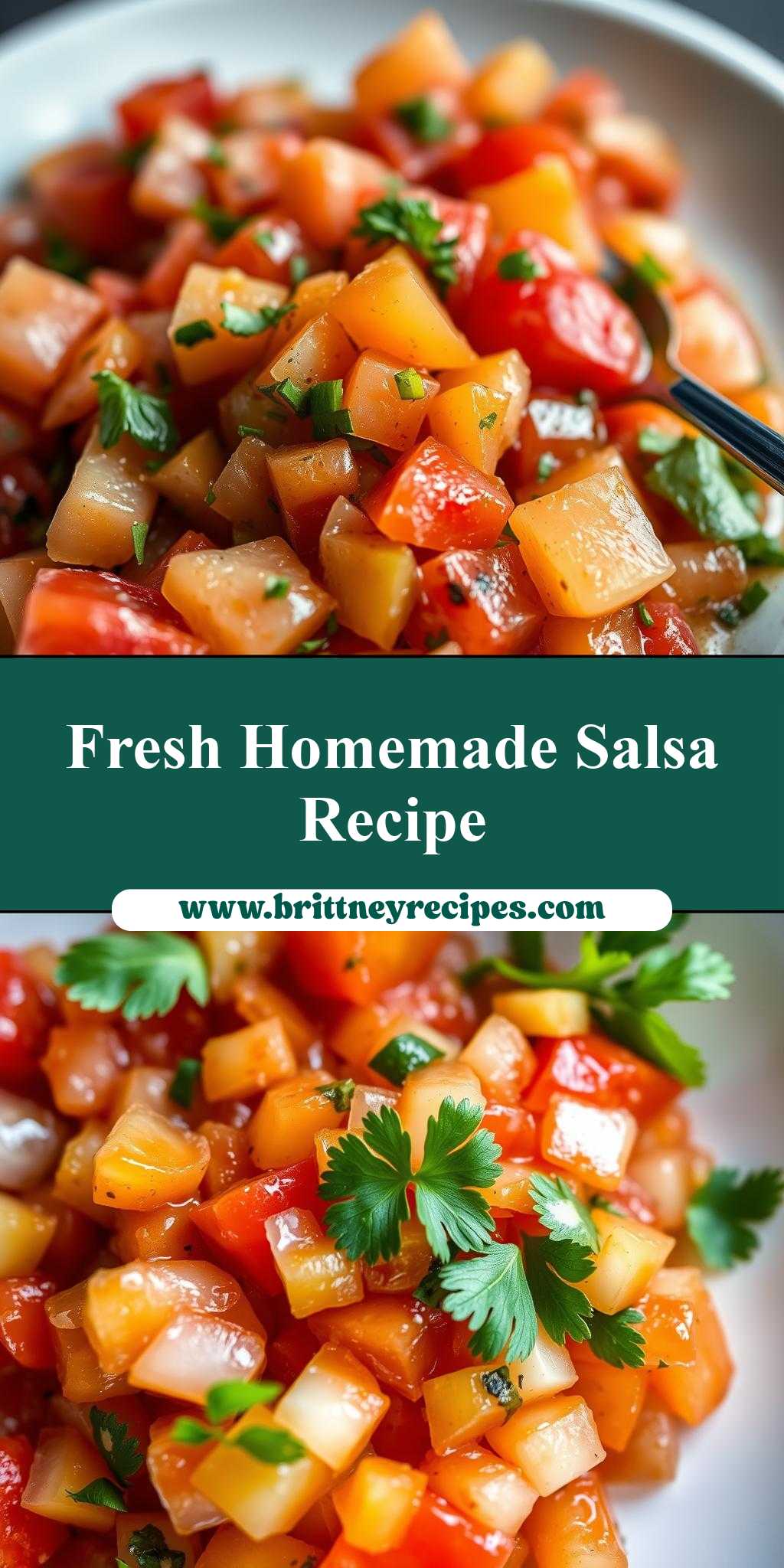What makes the perfect salsa recipe so addictive? This easy homemade version combines fresh tomatoes and jalapenos for a quick weeknight dinner favorite. Save this idea for a delicious family favorite to enjoy all year round, try it soon with your favorite dishes.
salsa recipe
Introduction
Salsa, the quintessential condiment of Mexican cuisine, brings a burst of flavor and freshness to any dish. What makes our salsa recipe stand out is its perfect balance of ease, flavor, and creativity, all achieved with everyday ingredients that you likely have in your pantry. Whether you’re a seasoned chef or a beginner in the kitchen, this recipe is designed to inspire your culinary journey with its simplicity and versatility. From the crunch of fresh vegetables to the zing of citrus, every component of this salsa is a testament to the magic that happens when simple ingredients come together in harmony.
Why This Works
- Flavor balance and ingredient accessibility: Our salsa recipe is carefully crafted to balance the sweetness of tomatoes, the tanginess of lime juice, and the spiciness of jalapeños, making it a perfect accompaniment to a wide range of dishes. The ingredients are easily accessible in most supermarkets, ensuring that you can whip up a batch whenever the craving strikes.
- Ease of preparation: One of the most appealing aspects of this recipe is its ease of preparation. With a few simple steps, you can transform basic ingredients into a delicious, restaurant-quality salsa that will impress family and friends alike.
- Impressive results with minimal effort: The beauty of this salsa recipe lies in its ability to deliver impressive results with minimal effort. Whether you’re hosting a party, looking for a quick snack, or simply wanting to elevate your mealtime, this salsa is sure to become a staple in your culinary repertoire.
Key Ingredients
The foundation of a great salsa is its ingredients, and our recipe focuses on using the freshest and most flavorful components. The main ingredients include diced tomatoes, which provide a rich, slightly sweet base; onions, which add a depth of flavor and a bit of crunch; jalapeños, contributing a spicy kick that can be adjusted to your taste; cilantro, with its fresh, herbal flavor; lime juice, which brings everything together with its bright, tangy taste; and garlic, adding a pungency that enhances the overall flavor profile. For practical substitutions, consider using different types of hot peppers for varying levels of heat or swapping cilantro with parsley for a slightly different flavor dynamic.
Instructions
- Step 1: Begin by preparing your ingredients. Dice the tomatoes, onions, and jalapeños, and chop the cilantro. Mince the garlic to release its oils and flavor. This step is crucial as it sets the stage for the texture and flavor distribution in your salsa.
- Step 2: In a large bowl, combine the diced tomatoes, onions, jalapeños, chopped cilantro, and minced garlic. The mixture might seem simple, but the combination of these ingredients is where the magic begins.
- Step 3: Squeeze the lime juice over the mixture and toss gently to combine. The acidity of the lime juice will help to balance the flavors and bring out the brightness in the other ingredients. This is also the stage where you can add any additional seasonings or ingredients to tailor the salsa to your taste.
- Step 4: Taste and adjust the seasoning as needed. If the salsa needs more heat, add more jalapeño. If it’s too spicy, a bit more lime juice or some diced mango can help cool it down. This final step is all about finding the perfect balance for your palate.
Handy Tips
- When working with jalapeños, be sure to wear gloves to protect your skin from the oils, which can cause irritation. Also, consider seeding the jalapeños for a milder flavor or leaving the seeds in for an extra kick.
- For the best flavor, use the freshest ingredients possible. Fresh cilantro and lime juice make a significant difference in the overall taste of the salsa.
- Avoid over-mixing the salsa, as this can make it too watery and lose its fresh, chunky texture. The goal is to have a salsa that’s cohesive but still retains the individuality of its components.
Heat Control
If you’re planning to cook your salsa, whether slightly to bring out the flavors or to can it for later use, the ideal temperature is around 180°F to 190°F (82°C to 88°C). This low and slow approach helps to preserve the flavors and textures of the ingredients. Timing can vary, but generally, a gentle simmer for about 20 minutes can help to meld the flavors together without losing the freshness of the salsa. Signs of doneness include a slightly thickened consistency and a deeper, richer flavor profile.
Crunch Factor
The crunch factor in salsa comes from the fresh, uncooked ingredients like onions, tomatoes, and cilantro. To maintain this crunch, it’s essential to not over-process the ingredients. A quick chop or dice is all that’s needed to preserve the texture. If you’re looking for an extra crunchy element, consider adding some diced fresh bell peppers or a sprinkle of toasted pumpkin seeds on top of the salsa before serving.
Pro Kitchen Tricks
- For a smoother salsa, roast the tomatoes and jalapeños in the oven before chopping them. This step adds a depth of flavor and a velvety texture that elevates the salsa to a new level.
- Use a variety of tomatoes for a more complex flavor. Combining cherry tomatoes for sweetness, grape tomatoes for acidity, and a few diced fresh tomatoes for freshness can create a salsa that’s both familiar and excitingly new.
- Experiment with different types of peppers to change up the heat level and flavor profile of your salsa. From the mild sweetness of Anaheim peppers to the intense heat of habaneros, the possibilities are endless.
Storage Tips
- Store your freshly made salsa in an airtight container in the refrigerator. It will keep for up to a week, allowing you to enjoy it with various dishes throughout the week.
- For longer storage, consider canning your salsa. Consider using a water bath canner and following safe canning practices to ensure that your salsa remains fresh and safe to eat for months to come.
- When reheating salsa, do so gently to prevent losing the fresh flavors. A quick stir in a pan over low heat or a few seconds in the microwave can warm it up without compromising its quality.
Gift Packaging Ideas
If you’re looking to share your delicious homemade salsa with friends and family, consider packaging it in decorative jars with a ribbon and a gift tag. You can also pair it with some crusty bread, tortilla chips, or fresh vegetables for a complete gift basket. For a more rustic look, wrap the jar in a piece of colorful cloth or paper and tie it with twine. Whatever method you choose, the personal touch of a homemade gift is sure to be appreciated.
Flavor Variations
- Different spices: Add a pinch of cumin for a smoky depth, some smoked paprika for a BBQ twist, or a bit of ground coriander for a Middle Eastern flair.
- Creative toppings: Experiment with different toppings like diced mango for sweetness, crumbled queso fresco for salty creaminess, or toasted nuts for added crunch.
- Ingredient swaps: Replace tomatoes with diced avocados for a creamy salsa, use lemon juice instead of lime for a different acidity level, or swap jalapeños with serrano peppers for an intense, crisp heat.
Troubleshooting
- Texture problems: If your salsa is too watery, try adding more diced vegetables or a bit of tomato paste to thicken it. If it’s too thick, a squeeze of lime juice or a bit of water can help achieve the perfect consistency.
- Ingredient replacements: Don’t have cilantro? Parsley or basil can work as substitutes, though they’ll change the flavor profile slightly. Out of jalapeños? Consider using other hot peppers or adjusting the amount of pepper to your desired heat level.
- Over/undercooking signs: If you’re cooking your salsa, be wary of overcooking, which can lead to a loss of flavor and texture. Undercooking, on the other hand, might result in flavors that haven’t fully melded together. Taste as you go and adjust the cooking time accordingly.
FAQs
- Can I freeze it? Yes, you can freeze salsa for up to 6 months. It’s best to freeze it in airtight containers or freezer bags, pressing out as much air as possible before sealing to prevent freezer burn.
- Is it gluten-free? Yes, this salsa recipe is naturally gluten-free, making it a great option for those with dietary restrictions.
- Can I double the recipe? Absolutely! This recipe is easily scalable. Just keep in mind that you may need to adjust the cooking time slightly if you’re planning to cook the salsa for canning or heating purposes.
Conclusion
Our salsa recipe is more than just a condiment; it’s an invitation to explore the vibrant world of flavors that await in your kitchen. With its ease of preparation, accessibility of ingredients, and the endless possibilities for customization, this salsa is sure to become a staple in your culinary adventures. Whether you’re a fan of spicy foods, a lover of fresh flavors, or simply looking for a new way to elevate your meals, this recipe is a journey worth taking. So go ahead, chop those onions, dice those tomatoes, and let the fiesta begin!

